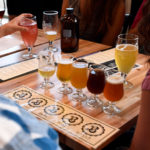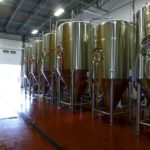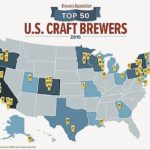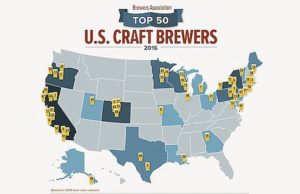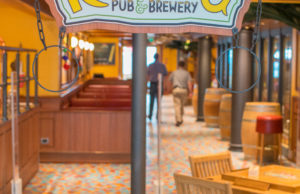25 most important American craft beers ever
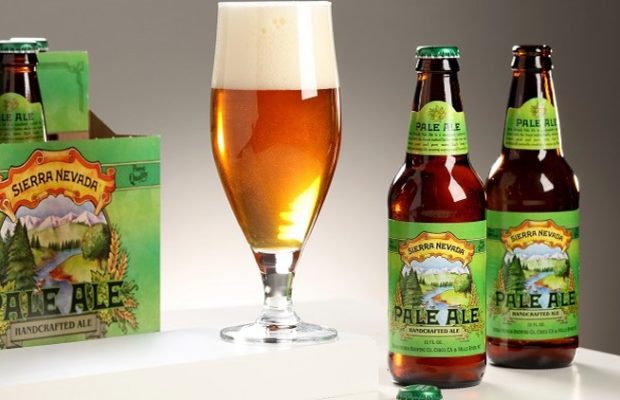
Click here to view original web page at www.myajc.com
Food & Wine had a great idea.
I’m borrowing it.
Last month, the magazine asked 21 beer industry luminaries to rank the most important craft beers of all time. Not the best, which would have been a ridiculous and impossible undertaking.
The most important.
As you might expect from a pack of luminaries, the list was fairly well-constructed. But after sharing it on social media and following with my own thoughts, most of which blew past 140 characters, there was only one thing to do: Make a list of my own.
What makes an “important” beer? To me, the definition is simple: It’s one that either changed consumer tastes or how breweries approach making beer. Some of the beers below have influenced both drinkers and brewers. Others hew more in one direction than the other. Others find their power in the brand or the package even more than the beer. As you’ll see, I agree with much of the Food & Wine list but also take several exceptions.
I’m interested in your opinions too. Feel free to email with the beer that has been most important to you, personally, with a few sentences explaining why, and we’ll follow up in the coming weeks with the readers’ say.
Until then, here is my ranking of the American craft beer industry’s 25 most important beers ever (which actually numbers more than that due to several ties):
1. Sierra Nevada Pale Ale (Sierra Nevada Brewing)
As simple as the concept is now, Sierra Nevada’s flagship beer was revolutionary in 1980: a hop-forward pale ale showcasing the spry citrus character of American-grown hops. Nothing like it had existed before on a commercial scale; now such beers line shelves of any and every reputable beer store in the country. There’s no other reasonable choice for the top spot. (Food & Wine rank: 1)
2. Sam Adams Boston Lager (Boston Beer)
Not the most exciting beer, but the company’s ambitious growth, crossed with founder Jim Koch’s marketing savvy — including a very public war of words with Anheuser-Busch during the 1990s — has arguably done more than any other brand to challenge the dominance of Bud, Miller and the old standbys. As Goose Island founder John Hall once told me: “Jim built a tent that the rest of us could step into.” (F&W: 2)
3. Bourbon County Stout (Goose Island Beer Co.)
When first released in 1995 (yes — it was 1995, not 1992 as the label says), an imperial stout aged in bourbon barrels might as well have been a lager brewed on Mars; it just didn’t exist. Goose Island gave the world a gift by coaxing those phenomenal flavors that result from imperial stout meeting whiskey barrel — vanilla, chocolate, coconut, marshmallow and oak. The evidence lies in the hundreds, if not thousands, of breweries that have followed suit. (F&W: 3)
4. Anchor Steam (Anchor Brewing)
The original American craft beer. End of story. (F&W: 11)
5. 90 Minute IPA (Dogfish Head Brewing)
Like “Jeopardy!” this spot began with an answer: hops. Hops have been the engine driving craft beer for more than a decade, and without an India pale in the top four, it was time for an India pale ale. Dozens of IPAs have been influential, which made zeroing in on one a challenge. But I settled on this classic, and without much consternation. Back in 1999, when many American craft breweries were still built on mimicking European beer styles, Delaware’s Dogfish Head changed how a nation thought about hops, with this boozy (9 percent alcohol), bitter (90 IBUs) and assertive imperial IPA. What made the beer even more important was the company’s aggressive distribution strategy, which made Dogfish the nation’s fastest-growing brewery by 2011 and put 90 Minute IPA in countless awestruck hands at a time that craft beer was building momentum toward the breakthrough that followed. (F&W: 23)
6. Blue Moon Belgian White (Blue Moon Brewing Co.; subsidiary of MillerCoors)
The Brewers Association defines a craft brewer, and MillerCoors certainly is not one. However, the Brewers Association does not define craft beer, and it is widely agreed: Blue Moon is a craft beer. Ubiquity and the power of that MillerCoors distribution network have made Blue Moon crucially important to the growth of craft beer; it has educated countless mainstream drinkers about the genius of the Belgian wit. (F&W: Not ranked)
7. Lagunitas IPA (Lagunitas Brewing)
Hard as it is to imagine, IPAs barely existed in 1995, which put this beer and its citrus-pine hop character ahead of its time. More subtly, but equally important: Lagunitas founder Tony Magee claims to be first to package an IPA simply as “IPA.” Until then, he has said, the style was largely portrayed as “I.P.A.” and with the sort of images — a raja, the Taj Mahal, a Bengal tiger — that nodded to the style’s history as a British export to India. If in fact Magee was first to package IPA without the periods and the campy iconography — and I’ve found no compelling evidence to the contrary — this beer has been even more influential than its tasty liquid (which has become the nation’s top-selling IPA). (F&W: Not ranked)
8. New Belgium Brewing Fat Tire/Bell’s Amber (tie)
No one cares much about amber ales anymore, but like Sam Adams Boston Lager, the style helped convert scores of craft drinkers in the ’80s and early ’90s. It also gave breweries the bedrock, high-volume beers that financed their ability to embrace the wilder experiments that have come to define the industry. (F&W: Neither ranked)
9. La Folie (New Belgium Brewing)
Long before oak-aged sour beers were popular in American brewing, there was La Folie. This showed a generation of brewers the possibilities. (F&W: 13)
10. Pliny the Elder (Russian River Brewing)
One of the original American cult beers, Pliny can’t be found outside of its tiny distribution footprint — California, Oregon, Colorado and Philadelphia — and that’s partly where the power of this imperial IPA lies. But the beer backs up the hype with superb balance: bold citrus-pine character, malt backbone and bitterness. (F&W: 7)
11. Dark Lord (Three Floyds Brewing)
Dark Lord has several firsts (or near firsts) to its credit: It is among the first prominent examples of an imperial stout featuring adjuncts — in this case, coffee, Mexican vanilla and Indian sugar. Its annual Dark Lord Day release helped birth the idea of beer as an event. And, for better or worse, it has fueled the notion of rarity as a prized commodity in craft beer. (F&W: 8)
12. Redhook ESB/Widmer Hefeweizen (tie)
Extra special bitter and hefeweizen don’t have much in common, but these beers are linked in history by one powerful force: Anheuser-Busch. Both Redhook and Widmer sold minority stakes to the St. Louis giant during the 1990s when big beer was first grappling with the emergence of craft. In Anheuser-Busch’s mighty distribution network, both these flagships vaulted to national prominence and reached many more taste buds than they otherwise would have. A dotted line can be drawn from those deals to Anheuser-Busch InBev’s acquisition of nine American craft breweries since 2011, which has the world’s largest beer company poised to become the nation’s largest producer of craft beer in the coming years. (F&W: Not ranked/19)
13. Anchor Liberty/Anchor Porter/Anchor Christmas Ale/Anchor Old Foghorn (tie)
Arguably America’s first modern IPA, porter, seasonal release and barleywine all came from the same brewery. Remarkable. (F&W: 6/21/17/unranked)
14. Celis White/New Albion Ale/Bert Grant’s IPA/Pete’s Wicked Ale (tie)
Ah, the dearly departed. In the early ‘90s, Celis popularized the Belgian wit style in the U.S. (and quite likely inspired the existence of Blue Moon). New Albion lasted only a handful of years, but no less than Sierra Nevada founder Ken Grossman cites it as an influence. Grant is widely credited with brewing the nation’s first IPA (Anchor Liberty wasn’t marketed as such, though that’s essentially what it is). Pete’s Brewing was one of the five largest craft breweries in the U.S. through the ‘90s and served as a prominent alternative to Budweiser and Miller. All are gone; none is forgotten. (F&W: 14/10/unranked/unranked)
15. Allagash White (Allagash Brewing)
Blue Moon taught a generation of mainstream beer drinkers to love Belgian wit. Allagash White did it with grace and style. And without an orange wedge. (F&W: 4)
16. Black Butte Porter (Deschutes Brewery)
Opting for a porter as a flagship in 1988 was a bold move. The fact that Black Butte continues to be a bedrock brand for Deschutes — and that porter is now an industrywide bedrock style — more than affirms the decision. (F&W: Not ranked)
17. Dale’s Pale Ale (Oskar Blues Brewery)
Sometimes it’s not just the liquid that makes a beer important. Dale’s Pale Ale was the first craft beer to be widely distributed in cans, forever changing what we reach for when we reach for a craft beer. The fact that the handsome blue, red and silver can housed a well-made 6.5 percent alcohol pale ale didn’t hurt either. (F&W: 15)
18. Arrogant Bastard Ale (Arrogant Brewing)
It was the attitude as much as the beer that made Arrogant Bastard such a revelation upon its release in 1997. Stone Brewing — which spun off Arrogant Brewing into its own company in 2016 — set out to challenge beer drinkers in a way that the industry had rarely done. This intensely bitter and snarky beer (“You’re not worthy” was the tag line) pushed craft to keep pushing. (F&W: Not ranked)
19. Brooklyn Lager/Yuengling Traditional Lager/Victory Prima Pils (tie)
I’m lumping in the lagers because they’ve had similar effects on validating a style once disdained within the industry. Brooklyn and Yuengling did it with volume. Victory did it by crafting the perfect pilsner. (F&W: Not ranked/Not ranked/9)
20. Heady Topper (The Alchemist)
This Vermont double IPA helped establish the East Coast as a legitimate source of world-class craft beer — on par at last with the West. It also helped launch the unfiltered “New England IPA” style that has enjoyed recent prominence. This beer is still better than 99 percent of them. (F&W: 5)
21. Hennepin (Brewery Ommegang) and Tank 7 (Boulevard Brewing) (tie)
Ommegang has never been the most buzzed-about American craft brewery but has long been one of the best. Modeled on the Belgian breweries adored by Ommegang founders Don Feinberg and Wendy Littlefield, Hennepin was the first craft saison made in the United States. Boulevard’s Tank 7 didn’t come along until 2009 but is as responsible as any American saison for bringing that style to the mainstream. (F&W: Neither ranked)
Ommegang has never been the most buzzed-about American craft brewery but has long been one of the best. Modeled on the Belgian breweries adored by Ommegang founders Don Feinberg and Wendy Littlefield, Hennepin was the first craft saison made in the United States. Boulevard’s Tank 7 didn’t come along until 2009 but is as responsible as any American saison for bringing that style to the mainstream. (F&W: Neither ranked)
22. Cuvee de Tomme (Port Brewing/Lost Abbey)
Tart bourbon barrel-aged fruit beer doesn’t sound so radical now, but during the 1990s, Cuvee de Tomme was a revelation for anyone who could find it. I’ve never tried this beer, but it has been on my to-do list since learning its place in history while researching that wonderful, persnickety yeast strain, Brettanomyces. This was one of the first American beers to use Brett. (F&W: 18)
23. Matilda (Goose Island Beer Co.)
Speaking of Brettanomyces, Goose Island was among the first breweries to mainstream that yeast with the 2005 introduction of Matilda, a tribute to legendary Belgian beer Orval. Goose Island needed more than a year to figure out how to make a beer with Brett. Most of the literature at the time was about how to keep it out of beer. Matilda quickly caught the attention of both customers and fellow brewers, which has helped make Brett an industry staple. (F&W: Not ranked)
24. Every beer ever from Firestone Walker Brewing and New Glarus Brewing
How have we gotten this far without any representation from America’s two best breweries? OK, problem solved.
25. Not Your Father’s Root Beer (Small Town Brewery)
Just kidding.




